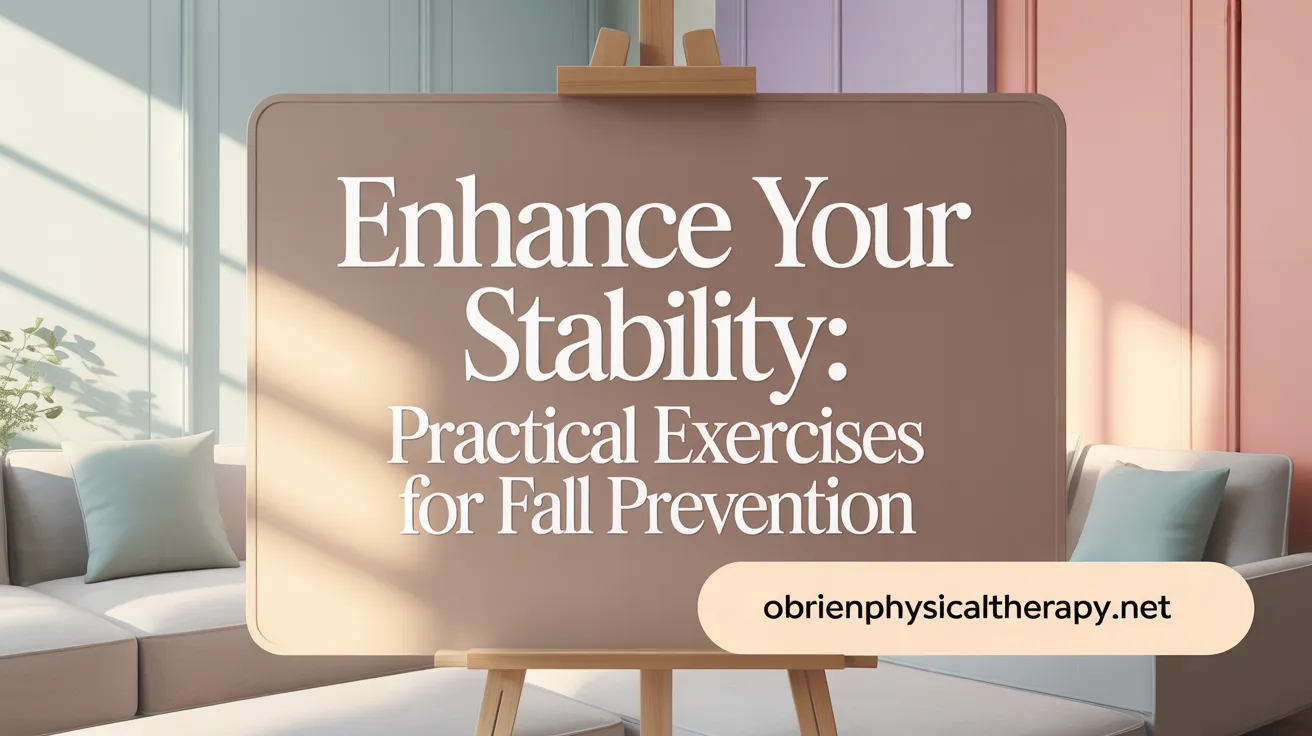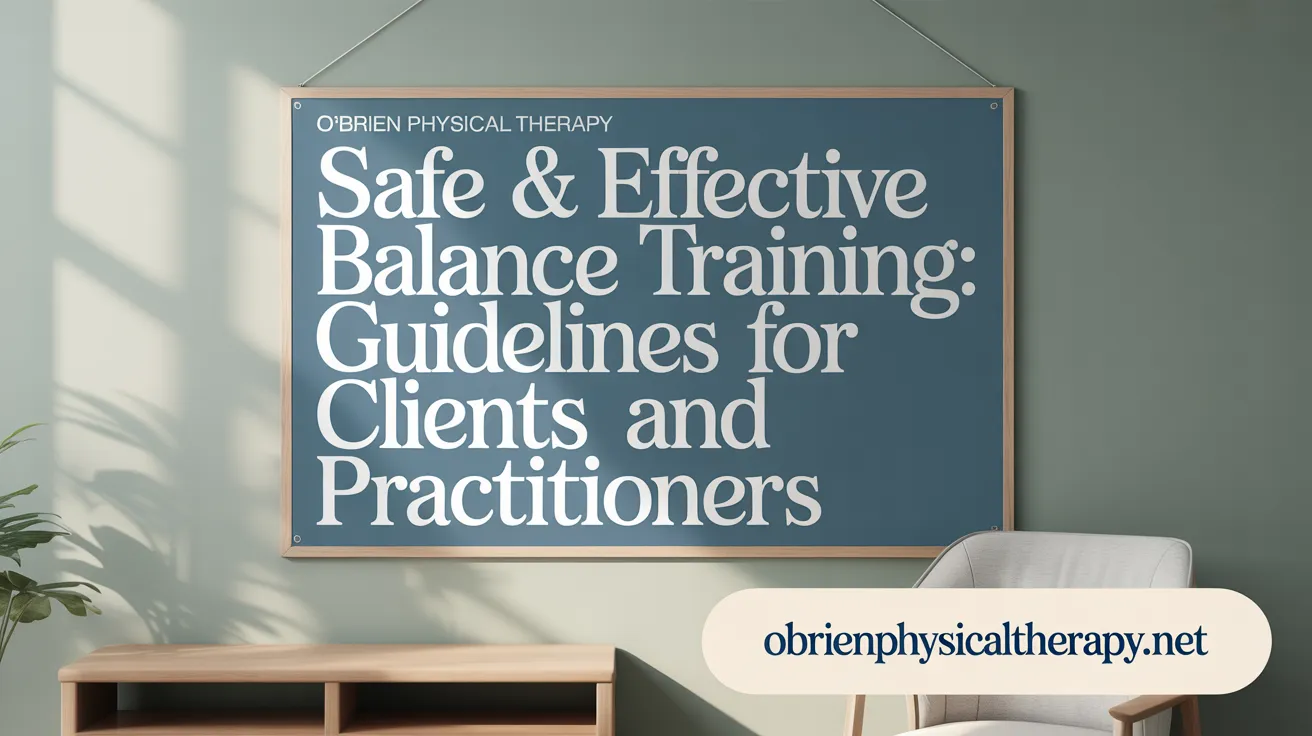Understanding the Importance of Balance Training in Fall Prevention
The significance of falls as a health risk among older adults
Falls are a major public health concern, with over 25% of adults age 65 and older experiencing a fall annually. These incidents often result in serious injuries such as fractures and head trauma, significantly affecting independence and quality of life. Falls are the leading cause of injury-related emergency visits and contribute to increased nursing home placements.
How balance declines with age and its impact on fall risk
As people age, natural declines occur in muscle strength, vision, and inner ear function—all vital for maintaining balance. This decline leads to increased body sway, instability, and a higher risk of falls. Conditions like vestibular dysfunction and polypharmacy can further exacerbate balance problems.
The role of physical activity and exercise in mitigating fall risks
Regular physical activity, including strength and balance exercises like sit-to-stand and single-leg stands, plays a crucial role in reducing fall risk. Programs incorporating aerobic, resistance, and balance training can improve muscle strength, coordination, and postural control, reversing age-related balance deterioration. Practices such as Tai Chi, interactive balance equipment, and physical therapy interventions help restore stability and confidence, making daily activities safer for older adults.
The Science Behind Balance and Fall Risk Reduction

What contributes to maintaining balance in older adults?
Balance is a complex ability relying on several systems: vision, the vestibular system (inner ear balance mechanisms), and proprioception (sensory feedback from muscles and joints). Declines in any of these areas can impair a person's stability, increasing fall risk. For more information, see balance problems in older adults and fall prevention strategies.
How does physical inactivity affect balance in the elderly?
Physical inactivity speeds up decline in balance and muscle strength, leading to higher fall risk. Regular physical activity counters this by maintaining muscle power, flexibility, and coordination. Learn about the impact of physical inactivity on balance decline and benefits of exercise.
Which types of exercise improve balance effectively?
Different exercise forms have demonstrated balance benefits for older adults:
- Resistance training strengthens muscles vital for postural control. See strength training benefits for older adults.
- Tai Chi, a low-impact meditative movement, improves coordination and reduces fall risk. More about Tai Chi for balance and fall risk reduction.
- Technological interventions using interactive games (e.g., Wii Fit) help improve static balance. Explore interactive video game exercises like Wii Fit.
How does combining aerobic and resistance training benefit balance?
Studies show combining aerobic exercises with resistance training enhances balance improvements more than either modality alone. This combination builds endurance, muscle strength, and neuromuscular coordination, which are all essential for stability. Read more on the combined aerobic and resistance training effectiveness.
How are sports rehabilitation programs related?
Sports rehabilitation programs in physical therapy support recovery by restoring strength, flexibility, and movement ranges. Evidence-based approaches also focus on injury prevention, addressing weak areas, and teaching proper techniques to help patients regain stability and reduce fall risk in daily life. Related resources include physical therapy for balance issues and fall prevention.
Practical Balance and Strength Exercises to Prevent Falls

What are some effective balance and strength exercises?
Improving balance and strength in older adults involves exercises designed to enhance stability and reduce fall risk. Common balance exercises include:
- Sit-to-Stand: Repeatedly rising from a sturdy chair to strengthen legs and improve body mechanics. See more on sit-to-stand exercise benefits.
- Single-Leg Stance: Standing on one foot to challenge balance and coordination. Learn about single-leg stance variations.
- Tandem Walking (heel-to-toe): Walking in a straight line to improve gait and postural control. Related info at balance and walking problems.
- Weight Shifts: Shifting weight from one foot to another to build dynamic balance. See recommendations on weight shifts and balance exercises.
Leg-strengthening exercises such as lunges and heel raises are essential as they bolster muscles critical for stability. For additional leg strength training exercises and fall prevention strategies, visit fall prevention exercises for elderly.
How do these exercises progress for safety and effectiveness?
Exercise routines typically start with simpler movements and gradually increase in difficulty:
- Begin balancing with feet apart for stability.
- Advance to feet together to challenge control.
- Progress to single-leg stands for higher balance demand.
- Incorporate eyes-closed variations to enhance proprioception.
Duration of holds can increase from 10 to 30 seconds, performed twice daily, with safety measures such as nearby support or supervision. For detailed stages of balance training and exercise progression, see exercise recommendations for fall prevention.
What are best practices for exercising safely?
- Perform exercises in a safe environment free of trip hazards. Check guidance on home safety and fall prevention.
- Use support (chairs or walls) when starting or for challenging exercises. For tips on safe balance training, see balance training benefits and safety measures.
- Consult healthcare professionals before beginning, especially if balance is weak or health issues exist. See advice on consulting healthcare before exercise and physical therapy for balance issues.
- Gradually build up intensity and complexity to avoid injury and ensure adherence. For comprehensive fall prevention strategies, check strength training and balance exercises.
These practical and progressive exercises form the foundation of personalized rehabilitation plans offered by physical therapy and wellness clinics, aiming to restore function and reduce fall risk effectively.
Specialized Physical Therapy Interventions for Balance Improvement

What are evidence-based treatments in physical therapy and wellness clinics?
Evidence-based treatments combine the best scientific research, clinical expertise, and patient preferences to provide safe, effective, and personalized care. In the context of balance and fall prevention, this approach ensures that interventions lead to meaningful improvements while minimizing risks.
Role of physical therapists in diagnosing and treating balance problems
Physical therapists are trained to assess balance issues through comprehensive evaluations of vision, vestibular system function, muscle strength, coordination, and proprioception. They develop individualized treatment plans addressing the underlying causes of balance impairment. Treatment focuses on enhancing muscle strength, flexibility, postural control, and building confidence to reduce fall risk. For more about physical therapy for balance problems, see Physical therapy for balance issues.
Vestibular rehabilitation therapy for dizziness and balance stabilization
For patients with dizziness and vestibular disorders, vestibular rehabilitation therapy (VRT) offers specialized exercises that promote balance retraining, visual tracking, and head-eye coordination. VRT improves the integration between the vestibular system, vision, and proprioceptive inputs, which stabilizes gait and reduces symptoms like dizziness, thus lowering the risk of falls. More details at Vestibular Rehabilitation Therapy.
Individualized treatment plans: strength, coordination, visual tracking, and proprioceptive exercises
Treatment plans are tailored to each person's needs and often include strength training for lower body muscles, coordination drills, visual tracking exercises to enhance focus and gaze stability, and proprioceptive training to improve body awareness. These exercises improve the body's sensory integration necessary for stable posture and balance during movement. For strategies on strength and balance, see Strength training and balance exercises can help prevent falls.
Use of advanced equipment like Biodex Balance System to improve dynamic balance and reduce fear of falling
Advanced technology, such as the Biodex Balance System, enables precise assessment and training of dynamic balance through controlled, progressive challenges. Balancing on unstable surfaces with biofeedback enhances muscle strength, coordination, and reaction times, which are critical in preventing falls. Programs using such equipment have demonstrated significant reductions in fear of falling and improved functional mobility in older adults.
Together, these specialized physical therapy interventions provide an evidence-based, comprehensive framework to improve balance, stability, and quality of life, particularly in aging populations at risk for falls. See also physical activity programs for balance improvement and exercise can help decrease fall risk elderly people for further reading.
Incorporating Holistic and Community-based Approaches to Balance Training

What holistic health services are commonly provided by physical therapy and wellness clinics?
Holistic health services in physical therapy and wellness clinics often include wellness counseling, nutrition guidance, stress management, and integrative therapies such as massage and acupuncture. These services focus on supporting the whole person and aim to enhance overall health, facilitating a more balanced and active lifestyle that complements balance-specific exercises.
How can community programs support balance and fall prevention?
Community programs like "A Matter of Balance" play a significant role in reducing the fear of falling among older adults while promoting increased physical activity. This evidence-based program educates participants on fall risk reduction through home safety adjustments and teaches exercises to improve strength and balance in a supportive group setting.
What are the benefits of practices like Tai Chi, yoga, and interactive video games in improving balance?
Tai Chi and yoga offer gentle, low-impact movements that enhance strength, flexibility, and balance, effectively reducing fall risk in older adults. Similarly, interactive video games like Wii Fit engage users in balance-training exercises that improve static stability while providing enjoyable and accessible ways to stay active.
Are there local options for balance classes and community programs in La Crosse, Wisconsin?
La Crosse offers several local fitness and wellness centers providing classes tailored to older adults, such as Tai Chi, yoga, and balance training programs. These centers often work with physical therapists to deliver personalized fall prevention and rehabilitation services, supporting community health and independence for seniors (vestibular rehabilitation therapy, fall prevention resources).
By integrating holistic health services with community-based programs and diverse exercise options, older adults in La Crosse and beyond can achieve better balance, confidence, and safety in their daily lives.
Addressing Women's Health and Age-specific Concerns in Balance Training

What specialized services do physical therapy clinics offer for women's health?
Physical therapy clinics provide specialized services tailored to women's unique health needs, including pelvic floor rehabilitation and prenatal/postnatal care. These treatments address issues such as urinary incontinence, pelvic pain, and muscle dysfunction through manual therapy, therapeutic exercises, and patient education, enhancing quality of life and functional ability. For more information, see physical therapy for balance issues and rehabilitation.
How are age-related musculoskeletal changes managed to support balance?
As women age, musculoskeletal changes like decreased muscle strength, joint stiffness, and postural shifts can negatively affect balance. Physical therapists develop individualized exercise programs that focus on strengthening, flexibility, and balance exercises to counteract these changes and reduce fall risk. These programs often include strength and balance exercises and combined aerobic and resistance training effectiveness, shown to effectively improve stability and reduce falls.
Why is personalization important in exercise programs for women?
Personalized exercise regimens consider each woman’s health history, fitness level, and specific challenges such as pregnancy, menopause, or osteoporosis. This approach ensures safety and effectiveness, addressing distinct balance impairments while accommodating women's physiological variations. Tailoring programs also aligns with consulting healthcare before exercise recommendations and the importance of balance training after age 65.
What does collaborative care look like in La Crosse for women’s health?
Collaborative care involves physical therapists working closely with obstetricians, gynecologists, and primary care providers to coordinate comprehensive care. In La Crosse, this teamwork enhances outcomes by integrating physical therapy into broader health management strategies for women, with services accessible through community wellness and rehabilitation centers. This model aligns with community-based static and dynamic balance exercises and programs like vestibular rehabilitation therapy for improving stability and quality of life.
Ensuring Safety and Effectiveness: Guidelines for Clients and Providers

Why Consult Healthcare Professionals Before Starting Balance and Strength Exercises?
Before beginning any new exercise routine, especially for those with balance issues or underlying health conditions, consulting a healthcare provider is essential. Professionals can assess individual risk factors such as medication use, vision changes, or postural challenges. Their guidance ensures exercises are safe, appropriately challenging, and tailored to the individual's needs, thereby reducing the risk of injury or adverse events.
How to Perform Exercises in Safe Environments with Support
Performing balance and strength exercises in a controlled, clutter-free environment minimizes hazards that could cause falls. Using stable objects like sturdy chairs or countertops for support is recommended initially, especially during challenging exercises such as single-leg stands or sit-to-stand maneuvers. This approach builds confidence and promotes proper technique while lowering fall risk (balance exercises to improve stability and prevent falls).
Why Supervision is Important During Exercise Progression
Increasing the difficulty of balance tasks—such as progressing from feet apart to eyes closed or unstable surfaces—should be done cautiously and preferably under supervision. Having a trained individual or companion nearby provides immediate assistance if balance is lost and encourages safe practice, helping clients to gradually improve without undue risk (supervised exercise for fall safety.
The Benefit of Combining Strength, Balance, Aerobic Training, and Environmental Modifications
A comprehensive fall prevention strategy includes more than just exercises. Combining strength training with aerobic activity and balance exercises improves muscular endurance, coordination, and neuromuscular control (combined aerobic and resistance training effectiveness). Simultaneously, environmental adjustments—like improving lighting and removing trip hazards—further decrease fall risk (home safety and fall prevention. This multi-faceted approach promotes independence and safety for older adults.
How Sports Rehabilitation Programs Support Physical Therapy Goals
Sports rehabilitation programs in physical therapy clinics emphasize safe recovery and injury prevention through customized training. By improving strength and functional ability, these programs support balance and reduce fall risk (physical therapy for balance issues). Individuals benefit from targeted exercises that address their unique needs while promoting active, pain-free living.
By adhering to these guidelines, clients and providers can work together to design effective, safe fall prevention programs tailored to each individual's needs and circumstances.
Maintaining Independence Through Effective Balance Training
The Benefits of Consistent Balance and Strength Training
Regular balance and strength exercises significantly reduce the risk of falls in older adults by improving stability, muscle strength, and coordination. These exercises can lead to a reduction in fall-related injuries, enhance confidence in movement, and support independence in daily activities.
Personalized Physical Therapy and Holistic Fall Prevention
Customized physical therapy plays a vital role in addressing individual balance deficits and underlying causes such as vestibular or neurological issues. A holistic approach, which includes strength training, balance exercises, home safety assessments, and medication review, is essential to effectively reduce fall risk.
Embracing Tailored Exercise Programs
Older adults are encouraged to engage in personalized exercise programs designed by healthcare professionals. These programs focus on gradual progression and safety, empowering individuals to improve their quality of life while minimizing the likelihood of falls through targeted strength and balance training.
